We all have objectives to complete that project, achieve a sales number, or participate in a 5K run. But there are stretch objectives: The bold, near impossible targets that force us to think bigger, act smarter, and push ourselves harder than we ever thought possible.
Stretch objectives can be daunting. Often, they look unattainable. But they are the very targets that drive innovation intention, motivation, and growth you previously thought impossible.
In this blog, we will unpack what stretch objectives are, how to set stretch objectives, common mistakes, and ways to make stretch objectives work for you. By the end, you will see how adopting stretch objectives can change your mindset and possibly your life.
Key Highlights:
- What Are Stretch Goals
- The Psychology of Stretch Goals
- Benefits of Stretch Goals for Individuals and Teams
- Stretch goals for leaders
- Stretch Goals in Different Industries
- Stretch Goals into Daily Habits
What Are Stretch Goals?
Stretch goals are goals that are ambitious and take you beyond your current abilities. There are different types of goals, normal goals are achievable and realistic. Stretch goals don’t operate on the same principles and set a higher bar (on purpose).
Think of them like this:
- Normal goal: Increase revenue by 10%.
- Stretch goal: Double sales within 12 months.
That goal will likely not be 100% achievable, but that is the point; stretch goals make you think creatively, resiliently, and innovatively.
The Psychology of Stretch Goals
Just why do stretch goals work? The answer lies in how our brains and feelings respond when we are challenged and forced out of our comfort zone.

1. Challenge Response
When we are faced with a difficult target, our brains switch into problem-solving mode. Rather than autopilot our brains turn on and begin looking for creative solutions to overcome challenges. This new focus tends to lead to bigger innovations and less oblivious thought.
2. Motivation Amplifier
Big goals act like fuel. They increase our energy much more than the small and easy wins we have achieved in the past. The act of aiming for something “just out of reach” is often able to create effort and persistence amounts that are much higher than you would expect.
3. Growth Trigger
Even if you don’t achieve the stretch target, you’ll still be able to accomplish more than if you had chosen the “safe” or modest target. Motivation to aim higher for a greater goal results in some potential for growth personally and professionally; otherwise unlikely to happen.
4. Risk & Reward Effect
Having outsiders’ goals gives you the possibility for more. They compel people or teams to take calculated risks that often provide the breakthroughs that regular incremental goals will never offer.
Stretch Goals vs. SMART Goals: Key Differences
| Aspect | Stretch Goals | SMART Goals |
|---|---|---|
| Focus | Big, bold, ambitious | Specific, realistic |
| Risk Level | High | Low to medium |
| Timeframe | Often long-term | Usually short to mid-term |
| Outcome | Innovation, breakthrough | Steady progress |
| Success Measure | Partial progress can still be huge wins | Full completion of specific goal |
7 Powerful Strategies to Set Stretch Goals That Work
Powerful Strategies to Set Stretch Goals are:
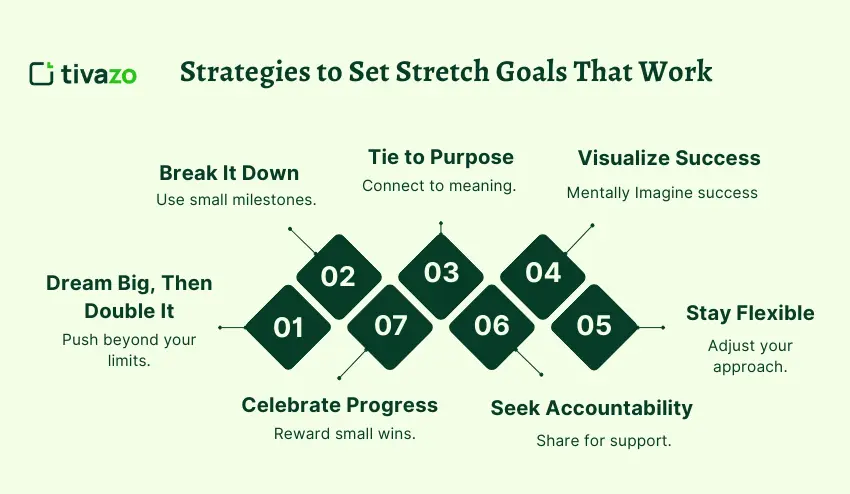
1. Dream Big, Then Double It
A true stretch goal should scare you a bit. If it seems easy or “comfortable,” then it probably isn’t ambitious enough. Start with what you think is a challenge, then move it further, if you have the capability, double it or 50 -100% what you have chosen. The goal should be just beyond your reach to allow you to think in new ways, question your assumptions, and stretch your capabilities.
Example: If your sales goal was $100K, your stretch goal would be $200K, and yes, you might think you would never reach it, and maybe you won’t, but however strong you work towards that stretch goal, it will make you go far beyond the original goal.
2. Break It Down
When stretch goals are viewed as a whole massive goal, it can feel daunting and impossible to do. So, break it down into smaller, actionable, and digestible milestones. Think of these mini-goals as stepping stones that give you a clearer path + provide you checkpoints for measuring progress.
Example: If your stretch goal is to run a marathon, first you would want to run 5K, then 10K, then half (21.1K) then the marathon. Each milestone builds confidence, and momentum.
3. Tie to Purpose
Stretch goals work better when they are aligned to something meaningful. Here, remind yourself what is the purpose of your target- whether it is personal growth, a team image, a purposeful vision, or benefits to your organization. If others see the “why,” they will be more likely to stay motivated to work towards it.
Example: A company stretch goal where carbon emissions are to reduce by 50% is a goal that is more than a proxy metric, it becomes a purpose driven future state goal that can provide inspiration for employees to innovate.
4. Visualize Success
Visualization is very powerful in your mind! Visualize reaching your stretch goal in every detail, how it looks, how it feels, what this establishes. This process of mental rehearsal grows your confidence and allows you to try to anticipate your obstacles before you hit them.
Example: A sales team could visualize closing a record number of deals, the excitement they felt closing deals, the celebratory moments they had with their colleagues. This instilled action in them every time.
5. Stay Flexible
Stretch goals are lofty, so chances are your first plan will not work. In reaching your target, you can be flexible in your means. You can be experimental, pivot, or change up your strategy without losing sight of your target goal.
Example: If the target goal was clearing the largest line of a new product, flexibility may mean changing marketing campaigns, redesigning product functions, or even trying new distribution options.
6. Seek Accountability
Accountability will significantly increase your odds of reaching a stretch goal. Tell your mentors, co-workers or peers about your plans. Ask for their help, their feedback, and their encouragement. Regular monitoring and reporting will help keep you honest and motivated.
Example: An alternative writers aspirations to publish a book may incorporate sharing of the work she produced weekly with a writing group or a writing mentor.
7. Celebrate Progress
Stretch goals are ambitious and it is unreasonable to hit 100% all the time but celebrate achievements, partial accomplishments, and all the lessons learned on the way. Recognizing the small successes keeps motivation alive within the team and creates a culture of success.
Example: If your team reaches 50% of a revenue stretch goal, celebrate it! It is proof that your hard work is making a noticeable difference and that the team is headed in the right direction!
Pitfalls to Avoid (Stretch Goal Paradox in Action)
Stretch goals are powerful, but a stretch goal is powerful enough to hurt you if you are not careful. So careful in fact that the Harvard Business Review calls it the “stretch goal paradox,” meaning sometimes goals that should motivate you, demotivate you, and a goal that is too “Easy” is not challenging. Here is a closer look at the pitfalls and how to avoid them:

1. Too Unrealistic → Demotivation
A stretch goal is meant to stretch you, not break you. If the goal feels impossible, it will likely overwhelm your team or you and develop stress, not inspiration. Any remaining motivation may make individuals feel like “Why even try?” and lose motivation altogether.
Solution: Ensure that your stretch goal is difficult but achievable. Use your past performance as a guide and aim high but not foolishly high. For instance, if your team sold 100 units last quarter, setting a goal of 105 is not a stretch but 500 units might be unrealistic.
2. No Resources → Frustration
Ambitious goals require resources, tools and support. A stretch goal without sufficient budget, people, training or technology will be frustrating even for the most motivated team.
Solution: Before agreeing to a goal, try to identify exactly what resources you will need and confirm they have been allocated. If you cannot secure adequate resources, consider changing timeframes, splitting the goal into stages or see if you can get assistance externally.
3. No Plan → Wishful Thinking
Big goal + no step-by-step plan = dreams. Stretch goals need a planned approach, including milestones, timelines, and clear responsibilities. If you don’t make time to plan, you’ll find yourself at a standstill when you don’t know the next step, the confusion increases, and the goal becomes an abstract “idea” instead of a concrete, measurable target.
Solution: Break your stretch goal into smaller achievable steps (mini SMART goals). Track your progress and adjust your plan when necessary. A well-thought-out plan turns ambition into action.
4. Too Many Stretch Goals → Burnout
Stretch goals can be invigorating; however, if there are more than one or two at any one time, it can paralyze you and/or your team. Stretch goals are difficult by their very nature. If you undertake multiple stretch goals without prioritization, it will produce stress, mistakes, and most likely feelings of burnout.
Solution: Only focus on 1-2 stretch goals at a time. Ensure everyone knows which ones are critical and why. Celebrate and recognize progress along the way to maintain motivation and momentum.
Benefits of Stretch Goals for Individuals and Teams
When stretch goals are defined well, they are much more than just “big numbers” in a dashboard; they are effective in unlocking potential and empowering growth. Sudden stretch goals pull people and teams out of habits and behind closed doors. Instead, new stretch goals trigger creativity, focus, and resiliency. Slow-moving goals usually reinforce default modes of behavior, but stretch goals compel people to think differently, try different things, and perform at all-time high levels.
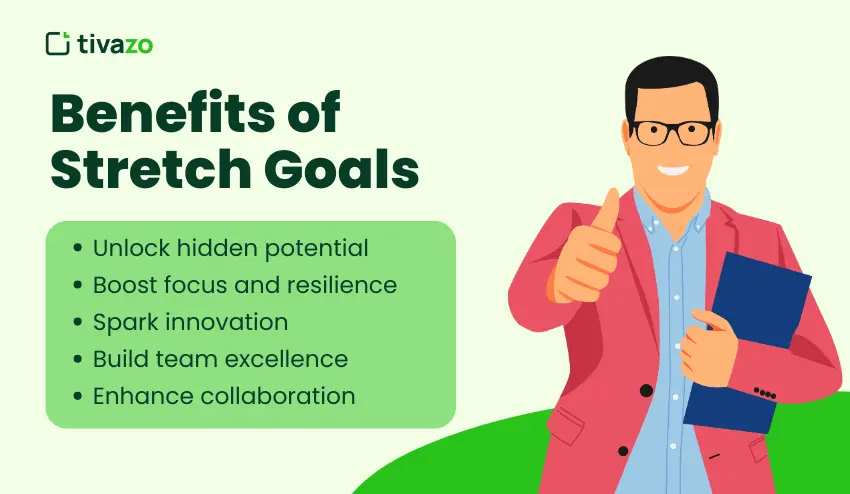
- They compel you to unleash dormant potential.
- They create greater focus and resiliency under stress.
- They force you to innovate and think differently.
- They build a culture of excellence within teams.
- They increase collaboration in the service of converged loft ambitions.
Even if you fall short, you will produce so much more than you would have when attempting “safe” things or a comfortably easy goal.
How Leaders Can Use Stretch Goals to Inspire Teams
Great leaders use stretch goals as a visioning tool, not to tax people.
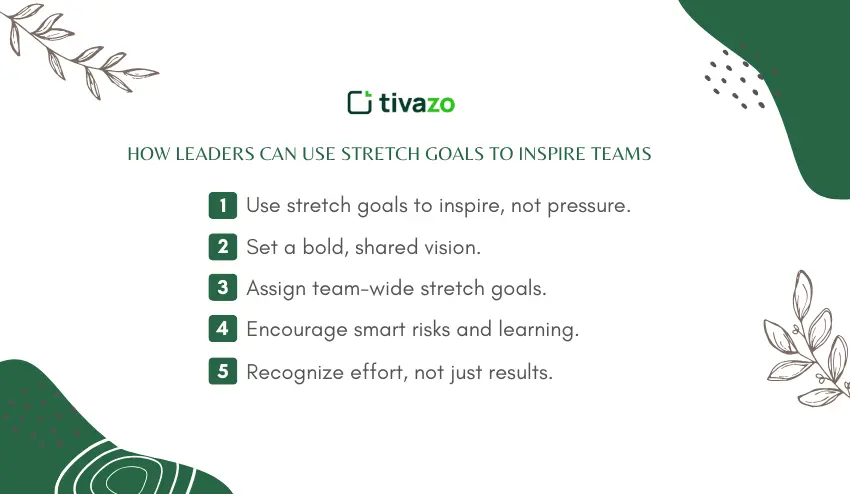
- Create an audacious vision for everyone to get behind.
- Allocate collective stretch goals (not just individual ones).
- Encourage reasonable risk-taking. A failure is not a disaster; it is a lesson.
- Acknowledge effort and innovation, not just achievement of the stretch goal.
Example: Elon Musk was not just interested in making cars he wanted to “accelerate the world’s transition to sustainable energy.” Stretch goal? Absolutely. Inspiring? Yes.
Stretch Goals in Different Industries
Stretch goals are not exclusive to the corporate world; in fact, they exist in every industry and are often the engines of extraordinary achievement.
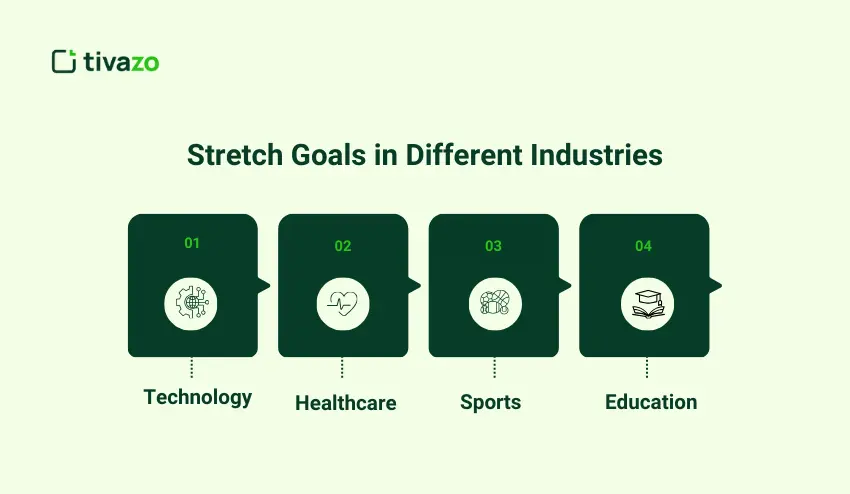
- Tech
- Google’s AI innovations or Apple’s dare of “1,000 songs in your pocket” made it clear that stretch goals will drive innovations and disrupt markets.
- Healthcare
- Eliminating Polio or curing genetic diseases are examples where stretch goals give researchers a reason to go beyond baby steps and instead achieve breakthroughs that will save lives.
- Sports
- When Michael Phelps set stretch goals that were primarily to break records for Olympic medals, he was not just able to elevate sports performance; he set historic measures of performance.
- Education
- When students set stretch goals such as graduating at the top of their class or receiving a major $250,000 scholarship, the focus and determination necessary to achieve it often leads to exceeding expectations.
All industries possess stretch goals; they are ultimately the lever of large-scale change.
Practical Tools & Frameworks to Track Stretch Goals
Setting stretch goals is only half the challenge; measuring progress and staying accountable is the other half. With out systems in place, there is a reasonable chance you will lose direction on those ambitious goals in the daily grind of unmanageable tasks. In this case, the right tools and frameworks will allow you or teams to break lofty targets into manageable chunks that allow for measuring progress and implementing changes along the way.
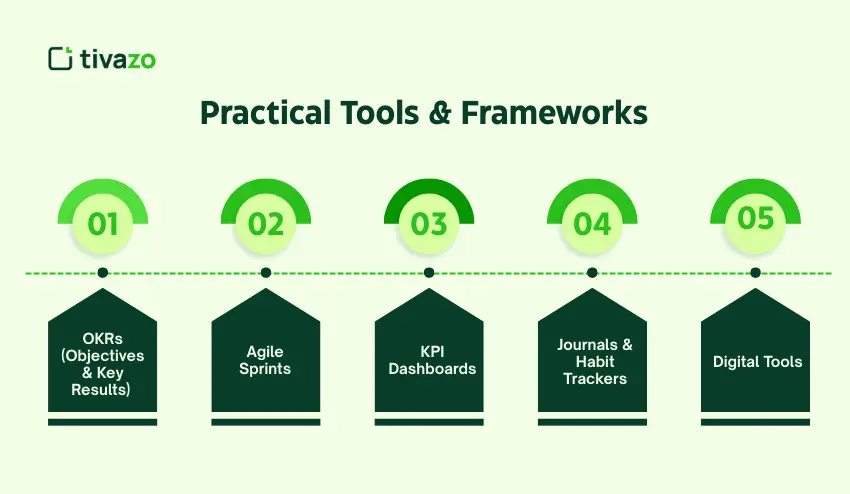
- OKRs (Objectives & Key Results) → Used by Google, Intel, LinkedIn.
- Agile Sprints → Break stretch goals into 2–4 week cycles.
- KPI Dashboards → Visualize progress.
- Journals & Habit Trackers → Provide individuals with consistent habits.
- Digital Tools → Timesheets & productivity systems to measure progress daily
How to Turn Stretch Goals into Daily Habits
Stretch goals work best when translated into daily actions. Actionable steps allow for small progress daily on lofty ambitions.
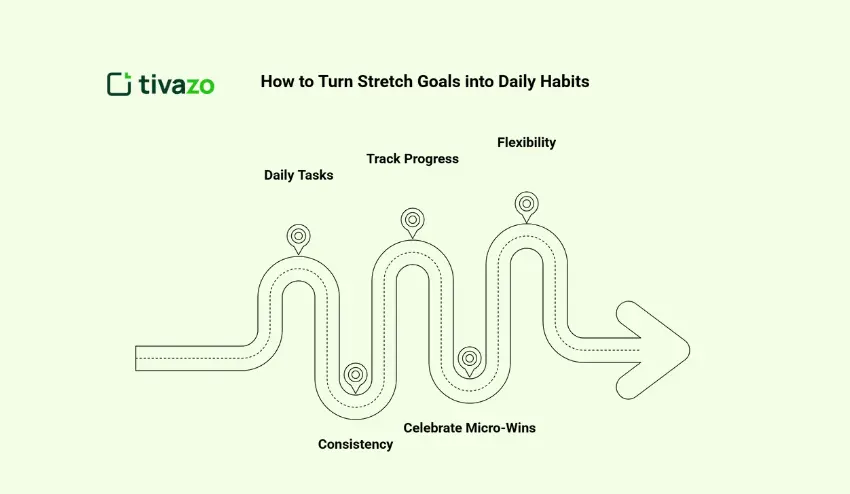
- Daily Tasks: Breaking into chunks of feasible actions
- Consistency: Build habits that build upon each other over time
- Track Progress: Using journals, apps.
- Celebrate Micro-Wins: Celebrate process at each milestone to stay motivated
- Remain Open to Flexibility: It is okay to change your process, but keep your goal intact
Make huge progress toward even the greatest stretch goal at a time!
Final Thoughts
Stretch goals are the expansive sky of personal and career growth. They can be hard at times, uncomfortable even, and they evolve the way you think and act.
Don’t be afraid to dream outside the box. Use SMART goals as stepping stones over the cracks, track outcomes with frameworks like OKR, and of course, enjoy the ride.
Because even if you miss the stars, you’ll land on the moon.




